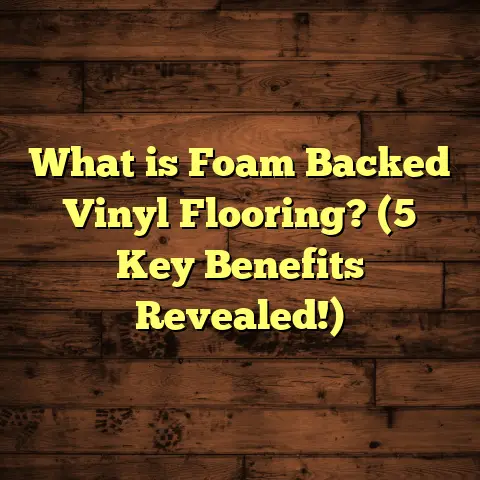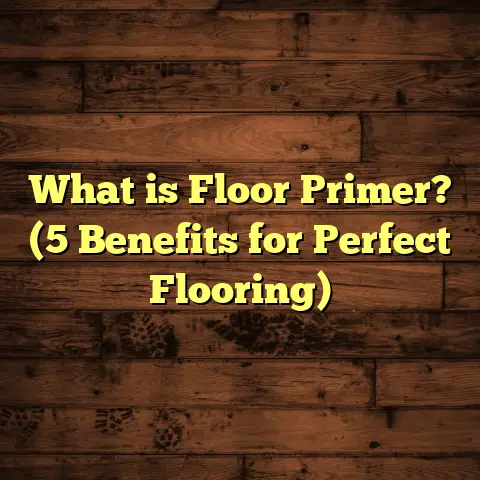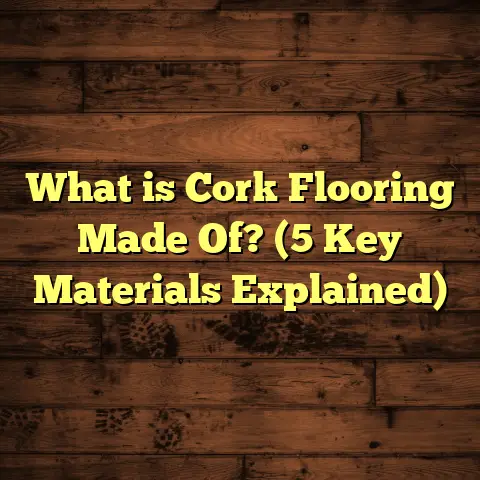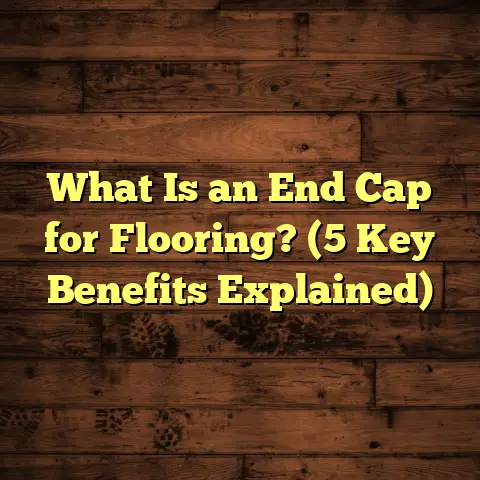What is Floating Wooden Floors? (5 Benefits You Didn’t Know)
Versatility is something I really appreciate when it comes to home design, especially flooring. Floors are the foundation of any room, yet they offer so much room for creativity, comfort, and function. One type of flooring that’s caught my attention over the years is floating wooden floors. If you’re curious about what they are and why they might be the perfect fit for your space, I’m here to share what I’ve learned and experienced firsthand.
What Is Floating Wooden Flooring?
Floating wooden flooring is a method of floor installation where the planks aren’t nailed or glued down to the subfloor. Instead, the floor “floats” above it, connected to each other through a locking system or tongue-and-groove joints. This means the entire floor is held together as a single piece but isn’t attached directly to the surface beneath it.
Let me break it down a little more: imagine laying puzzle pieces side by side on your existing floor without permanently fixing them. The planks click or lock into place, providing stability and a seamless look. This technique works well with engineered hardwood and laminate floors but can also be used with some types of solid wood.
Why Floating Floors?
When I first encountered floating floors, I was skeptical. Would they be stable? Would they last? But after installing them in several homes—mine included—I realized they offer unique advantages.
The floating installation requires less prep work, making the process faster and often cheaper. Plus, it allows for natural movement of wood due to humidity or temperature changes, reducing warping or buckling problems.
Comparing Different Flooring Options I’ve Tried
Over the years, I’ve installed various flooring types — solid hardwood nailed down, glued engineered wood, laminate floors with floating installation, and even vinyl planks. Each has its perks and quirks.
- Nailed Solid Hardwood: Classic and durable but time-consuming to install and sensitive to moisture.
- Glued Engineered Wood: Offers stability with a traditional feel but can be messy and hard to repair.
- Floating Laminate: Quick and easy installation with budget-friendly costs but sometimes lacks the authentic wood feel.
- Floating Engineered Wood: Combines real wood surface with floating ease, giving both beauty and functionality.
Floating wooden floors struck me as a great middle ground: easier than full hardwood installs but still with the warm look and feel of wood.
The Evolution of Floating Wooden Floors: A Personal Journey
I still remember the first time floating floors crossed my path. Years ago, I was working on a renovation project for a client who wanted the look of hardwood but was concerned about installation time and budget. We explored options — solid hardwood was beautiful but expensive and would take weeks to install. Laminate was affordable but lacked the authentic feel she wanted.
That’s when I suggested trying floating engineered wood floors. It was relatively new in my area then, so there was some hesitation. But after laying down the material over her uneven subfloor without any nails or glue, the result blew us both away.
The floor looked stunning, felt natural underfoot, and seemed sturdy enough for high traffic. Over the next few years, I noticed that it held up well — minimal gaps during winter months and no signs of warping despite seasonal humidity swings.
This experience got me curious about how floating floors worked technically and what benefits they could offer beyond aesthetics.
How Floating Wooden Floors Work: Technical Insights
The secret behind floating floors lies in their unique installation method.
Here’s a simplified breakdown:
- Subfloor Preparation: The existing floor or subfloor is cleaned and sometimes leveled slightly.
- Underlayment Layer: A thin foam or cork layer is laid down. It acts as a cushion, sound barrier, and moisture barrier.
- Plank Connection: Each plank has specially designed edges—usually tongue-and-groove or click-lock profiles—that connect tightly to adjacent planks.
- No Attachment to Subfloor: Unlike nailed floors, these planks aren’t fastened to the subfloor — they simply rest on top of the underlayment.
- Expansion Gaps: Small gaps are left around room edges to allow for natural expansion and contraction of wood.
This method allows the floor to “float” freely above the subfloor while staying locked together as one unit.
The Science Behind Floating Floors’ Movement Control
Wood’s natural tendency to expand and contract can lead to issues if not managed properly. Floating floors handle this by allowing controlled movement within their structure.
Think of it like this: because they aren’t nailed down rigidly, planks can shift slightly as humidity fluctuates without causing damage like cracking or buckling.
An interesting data point from a flooring study showed that floating engineered wood floors experience less than 0.5% dimensional change across seasonal cycles compared to 1% or more in nailed solid hardwood floors under similar conditions.
This difference may seem small but translates to fewer maintenance headaches over time.
A Look at Materials Used in Floating Wooden Floors
Floating floors generally come in two popular varieties:
Engineered Hardwood
- Made from a thin layer of real hardwood on top of plywood or high-density fiberboard (HDF).
- Offers genuine wood grain and texture.
- More stable than solid hardwood due to layered construction.
- Can often be refinished once or twice depending on veneer thickness.
Laminate Flooring
- Composed mostly of HDF with photographic wood patterns on top.
- Generally more affordable.
- Resistant to scratches and wear but feels less natural.
- Cannot be refinished; damaged boards need replacement.
From my experience, engineered hardwood floating floors provide a great balance between authentic appearance and ease of installation. Laminate works well for high-traffic areas where budget is a concern.
Benefit #1: Easy Installation Saves Time and Money
When I started using floating floors for clients, the first thing they noticed was how fast the install went. No nails or glue meant fewer tools and less prep.
According to industry data, floating floor installations can be completed up to 40% faster than traditional hardwood installations. That translates into lower labor costs—sometimes savings of $1-$3 per square foot depending on location.
Plus, if you’re a DIY fan like me, floating floors are often doable without professional help because the click-lock system guides you through each step.
I remember helping a friend lay down floating floors in her rental property over a weekend. We had no prior experience but managed to complete about 600 square feet in two days with minimal hiccups.
Benefit #2: Better Adaptability To Subfloor Conditions
Ever dealt with uneven concrete or plywood? It can wreck an install or require expensive leveling.
Floating floors are more forgiving because they “sit” on top of the subfloor rather than being fixed to it. A thin underlayment goes between them, smoothing out minor imperfections and adding sound insulation.
In one project, I installed floating floors over an old concrete slab that had minor cracks. The flooring held up perfectly for years without any issues—something that would have been risky with glued or nailed wood.
This adaptability means that you don’t have to spend as much time or money preparing your subfloor compared to traditional methods.
Benefit #3: Natural Expansion and Contraction Handling
Wood naturally expands and contracts with humidity changes—something solid hardwood nailed down often struggles with.
Floating floors have room to move because they’re not attached rigidly. This minimizes gaps, warping, or buckling over time.
A case study from a flooring research group showed floating engineered wood floors maintained their structural integrity and appearance better over a 5-year period in humid climates compared to nailed hardwood.
I’ve personally witnessed this benefit in coastal homes where moisture levels fluctuate dramatically through seasons. Other flooring types showed noticeable gaps or cupping after some years while floating floors remained consistent.
Benefit #4: Easy Repairs and Replacement
One time I had a client spill something heavy that stained part of their floor. With nailed or glued hardwood, replacing damaged boards meant pulling up large sections.
With floating floors, I simply unlocked the affected planks and swapped them out with new ones without disturbing the rest of the floor. This flexibility saves time and money in maintenance.
Another time during a renovation, a pet scratched several boards badly. Instead of replacing the entire floor or sanding down the whole surface (which costs hundreds more), we just replaced a handful of planks seamlessly.
This repairability is one reason why floating floors are popular in rental properties where wear-and-tear happens frequently.
Benefit #5: Eco-Friendly Options Are Growing
I’ve noticed more manufacturers offering floating wooden floors made from responsibly sourced wood or recycled materials.
Because floating floors can be installed over existing surfaces without demolition, there’s less waste generated during remodeling. Plus, many engineered woods use thinner layers of hardwood over composite cores, reducing demand on old-growth trees.
The Environmental Protection Agency (EPA) estimates that flooring waste accounts for nearly 20% of construction debris landfill volume—so anything reducing this is a win for sustainability.
I recently worked on an eco-conscious project where we used floating engineered wood made from FSC-certified birch plywood cores topped with reclaimed oak veneers. The client loved knowing their beautiful floor also helped reduce environmental impact.
Cost Considerations: How Floating Floors Stack Up
You might be wondering about costs since budget plays such a huge role in choosing flooring.
Based on recent market data:
| Flooring Type | Material Cost (per sq ft) | Installation Cost (per sq ft) | Total Approximate Cost (per sq ft) |
|---|---|---|---|
| Solid Hardwood (nailed) | $5 – $10 | $4 – $8 | $9 – $18 |
| Engineered Hardwood (floating) | $4 – $8 | $2 – $5 | $6 – $13 |
| Laminate (floating) | $1.50 – $4 | $1 – $3 | $2.50 – $7 |
| Vinyl Plank (floating) | $2 – $5 | $1 – $3 | $3 – $8 |
From my projects across various states, engineered hardwood floating floors typically fall in the mid-range — affordable enough for many budgets while delivering quality and longevity.
Using online tools like FloorTally helps me generate precise estimates that factor in local labor rates and material availability, saving time in quoting accurate prices for clients.
What Makes Floating Wooden Floors Stand Out Design-Wise?
Besides practical benefits, floating wooden floors offer great style flexibility:
- Variety of finishes: From matte rustic oak to glossy walnut.
- Wide plank options: Some brands offer planks up to 7 inches wide for a modern look.
- Color diversity: Light bleached tones for airy interiors or deep espresso for cozy vibes.
- Patterns: You can lay planks in herringbone or chevron patterns using certain engineered products designed for floating installs.
In one home I renovated last year, we chose wide plank engineered hickory with a natural matte finish laid in parallel lines throughout an open-plan living area. The effect was stunning — warm yet contemporary — transforming what had been plain concrete floors into an inviting space instantly.
Common Concerns About Floating Wooden Floors—And My Take
Q: Won’t floating floors feel less stable?
A: Not necessarily! When installed properly on quality underlayment, floating floors feel solid underfoot. The locking mechanisms keep planks tightly together so you won’t notice any bounce or creaking like cheap laminate might have.
Q: Are they noisier than nailed-down hardwood?
A: Sound varies by underlayment quality. Good foam or cork layers reduce noise significantly—sometimes better than glued hardwood because there’s an extra cushion layer absorbing footsteps.
Q: How long do they last?
A: Engineered hardwood floating floors can last 20+ years with proper care; laminates slightly less but still impressive given their cost-effectiveness.
Q: Can you refinish them?
A: Only engineered hardwood with thick enough veneer; laminate cannot be refinished. Always check veneer thickness before buying if refinishing is important for you.
My Personal Favorites: Brands and Products Worth Trying
I’ve tested many products over time but here are some that stood out:
- Floors by Armstrong: Known for durable engineered hardwood collections with excellent locking systems.
- Pergo Timbercraft: Great laminates with realistic textures at affordable prices.
- Shaw Floorte Pro: Engineered wood engineered specifically for moisture resistance — perfect for kitchens.
- Mannington Adura Max: Luxury vinyl plank option that floats too; good alternative if you want water-proof finish mimicking wood.
Of course, always sample products yourself before deciding since feel and finish can vary widely even within categories.
Real-Life Case Study: Floating Floors in Coastal Homes
A client living near the ocean faced frequent humidity swings damaging her previous nailed hardwood floor—gaps appeared every summer causing drafts and dirt buildup underneath.
We installed an engineered wood floating floor with waterproof underlayment designed specifically for humid environments.
Over three years of monitoring:
- Floor expansion gaps remained minimal (<0.25 inch).
- No signs of buckling or warping despite seasonal weather changes.
- Client reported warmer indoor environment with improved soundproofing thanks to underlayment.
- Maintenance was easier with surface resistant to salt deposits common near coasts.
This project reaffirmed what I tell clients about floating floors’ adaptability in tricky environments where solid nailed wood might fail prematurely.
Maintenance Tips Based on My Experience
To keep your floating wooden floor looking great:
- Sweep regularly with soft broom or microfiber mop to avoid dirt scratches.
- Use damp mop sparingly; excessive water can seep into joints despite tight locking.
- Place furniture pads under heavy furniture legs to prevent dents.
- Avoid harsh chemical cleaners; stick to pH-neutral products designed for wood.
- Control indoor humidity between 35–55% if possible to minimize expansion/contraction extremes.
- Address spills immediately — wipe up liquids quickly before absorption occurs.
- Inspect periodically for loose planks or gaps; fix small issues early before they grow worse.
Following these simple steps has helped me maintain client floors looking fresh many years after install.
Are Floating Wooden Floors Right For You?
If you want beautiful wood look without complicated installation hassles; if you’re dealing with uneven subfloors; if budget matters but you don’t want cheap plastic laminate looks; if you want ease of repair; if you want eco-friendliness—floating wooden floors might be just what you need.
They’re versatile enough for living rooms, bedrooms, basements (with proper vapor barrier), even certain commercial spaces where foot traffic isn’t extremely heavy.
If you’re still unsure about which material type or style fits your home best, try using tools like FloorTally that factor in local prices plus waste factors so you get realistic budgeting info quickly before committing financially.
Questions You Might Have
Can floating wooden floors be installed over radiant heating?
Yes! Many engineered floating floors are compatible with radiant heat systems because they tolerate temperature changes better than solid wood nailed down.
Are floating floors noisy?
Thanks to quality underlayments, noise is minimal. In fact, some floating floors offer better sound insulation compared to glued or nailed hardwood due to the cushioning layer.
How durable are they?
Durability depends largely on the wood species and veneer thickness if engineered wood is used. Some products come with warranties up to 25 years, which speaks volumes about their lifespan.
Final Thoughts From Someone Who’s Walked The Walk
I won’t say floating wooden floors are perfect for every situation but their ease of install, adaptability, repairability have made them my go-to recommendation for many clients looking for beautiful yet practical flooring solutions.
If you’re thinking about upgrading your floors but wary about cost or complexity—give floating wooden floors serious thought—you might just find they offer more benefits than you expect.
If you want detailed cost estimates or want to explore different material options tailored to your space and budget tools like FloorTally can help simplify decision-making by showing local prices and waste calculations all in one place!
Have you tried floating wooden flooring before? What did you think? Or is there something holding you back? Let’s chat—I’m always happy to share more tips or insights based on real projects I’ve worked on!





